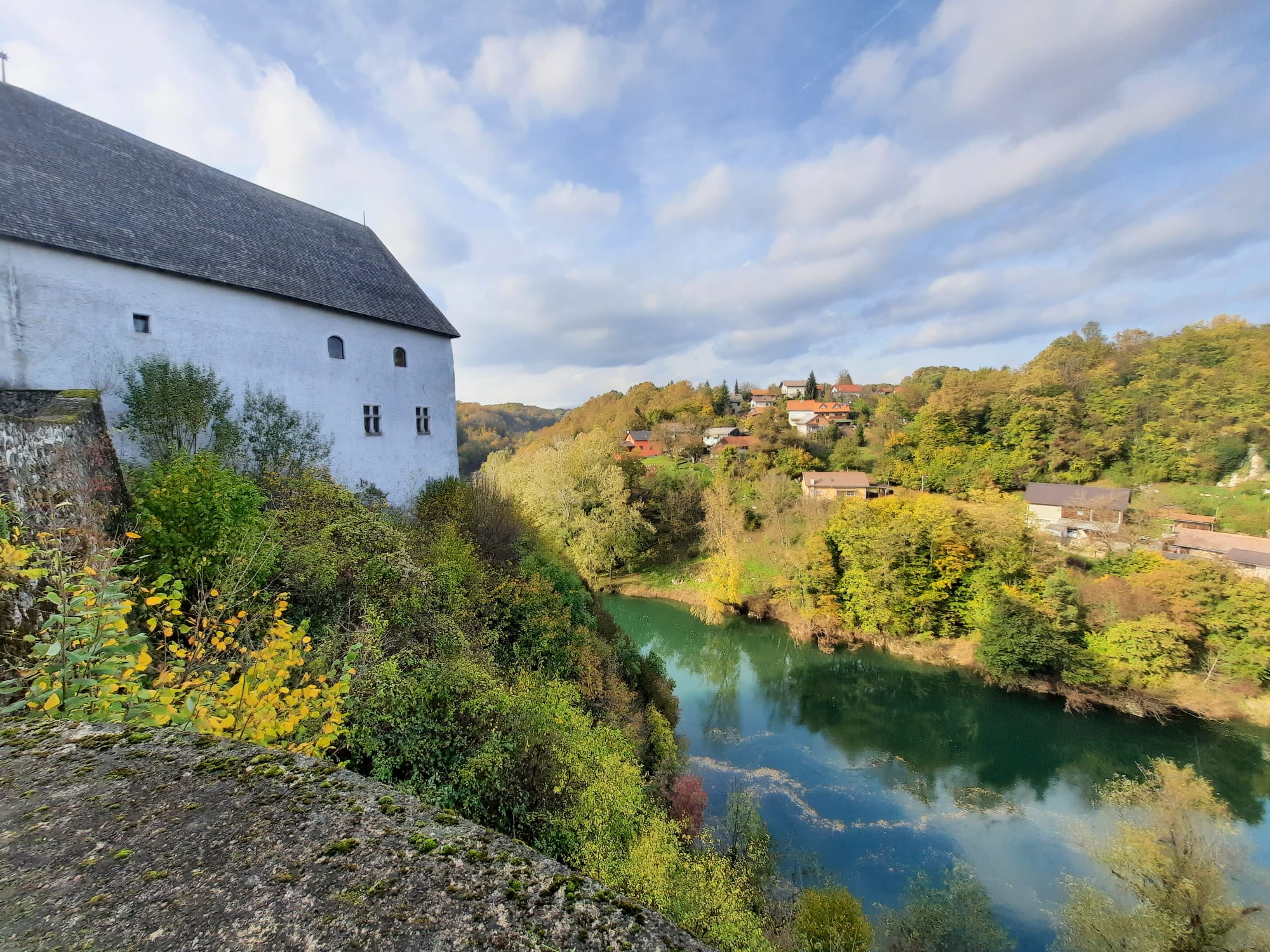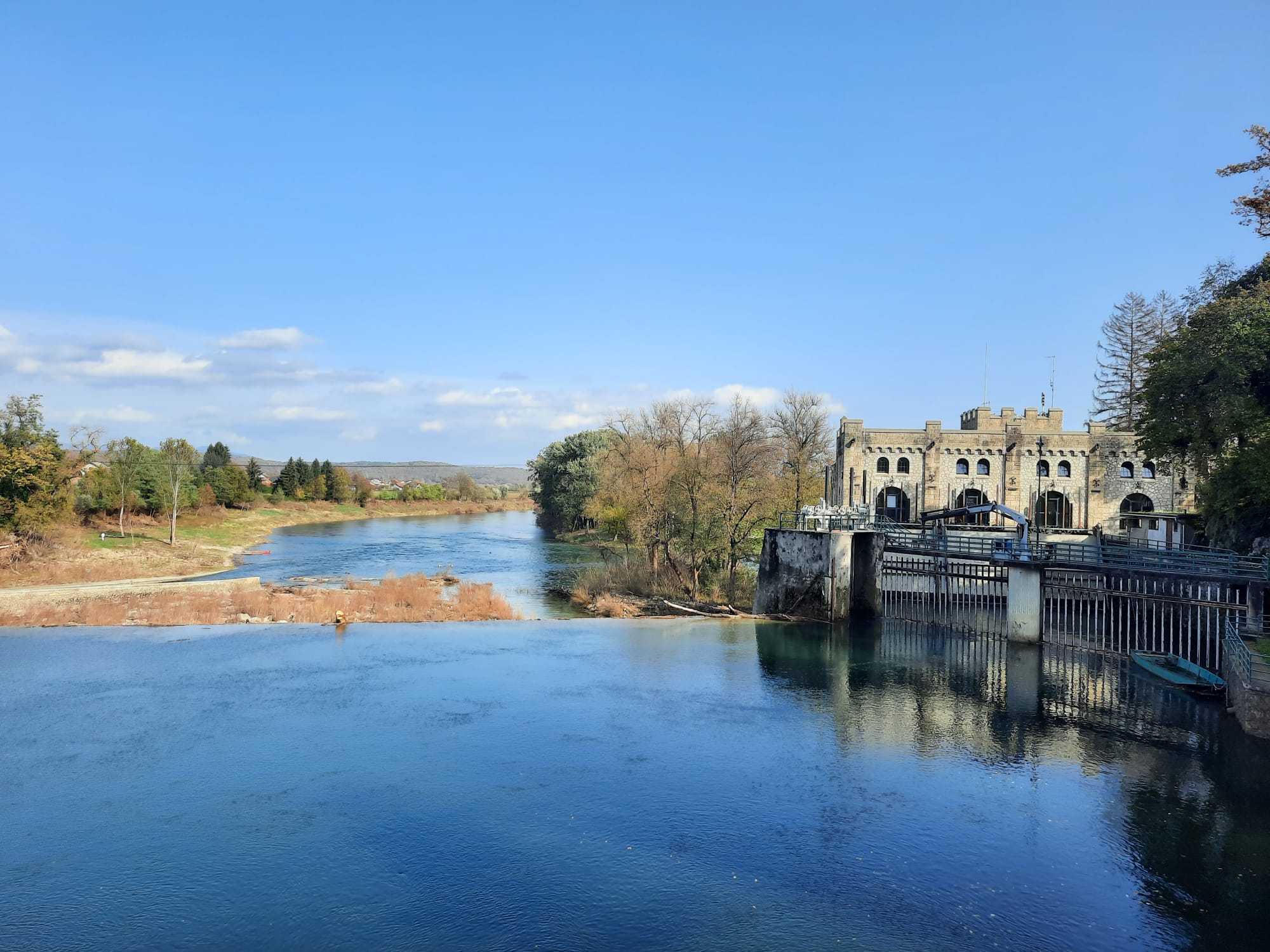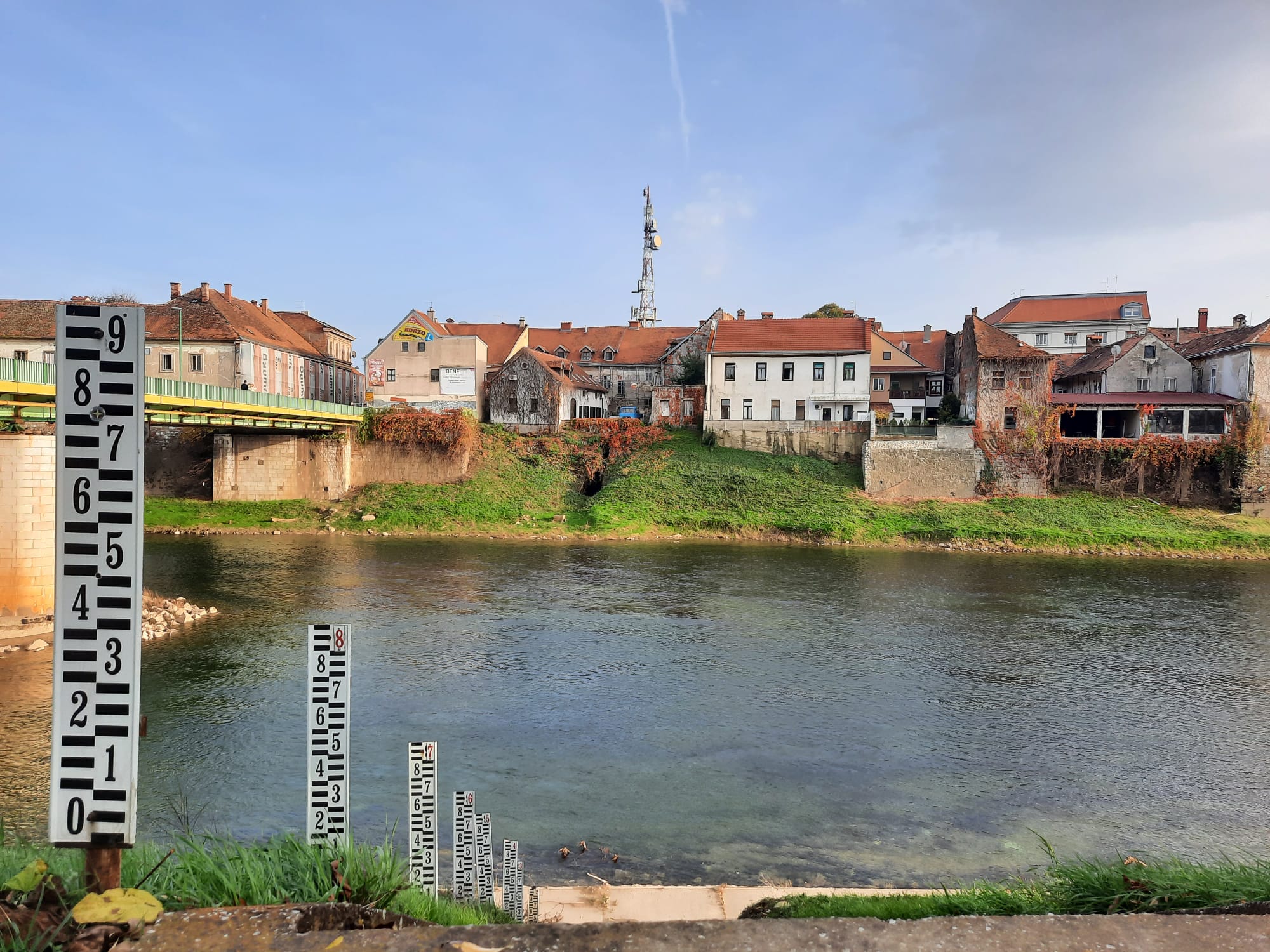
The old town of Ozalj, before Karlovac on the Kupa (Photo G. Vale)
Few cities can boast of being crossed by four rivers. Karlovac is one of them. Kupa, Dobra, Korana, and Mrežnica. A river city that saw its golden age towards the end of the eighteenth century. Our reportage continues along the Kupa River
(Read the first and second episode of the reportage devoted to the Kupa)
Few cities can boast of being crossed by four rivers. Karlovac is one of them. The fortress-city built by the Habsburgs in 1579 hosts an intricate blue tangle within its territory. The Kupa descends from the border with Slovenia to the north and, just before touching the historic centre, it recovers the Dobra, a tributary that flows about a hundred kilometres to the west in the Gorski Kotar region. From the south comes the Mrežnica, which runs almost parallel to the Dobra before flowing into the Korana, right in Karlovac. The latter then enters the Kupa east of the centre.
Within a few kilometres, therefore, the river that we have begun to follow from its source in the Risnjak national park welcomes three streams into its bed: Dobra, Mrežnica, and Korana. A song helps those who are not from Karlovac to memorize the four names: «Na Mrežnici se kupa. Korana, dobra bila si tad», which could be translated as: «One bathes in the Mrežnica. Korana, how beautiful you were then". The song is significant: since its foundation, just over four centuries ago, Karlovac has built its identity around the rivers that flow through it and the Kupa, in particular, has been responsible for the city's golden age.
Soldiers, traders, and industrialists
Within this river network, halfway between Zagreb and Rijeka, Karlovac was born as a military stronghold, a star-shaped fortress with six points. It was the 16th century and the Military Frontier was fast becoming an institution in the Habsburg Empire. From Senj on the Adriatic Sea to Zemun in Serbia and then through present-day Romania and Hungary, the Militärgrenze separates the Habsburg Empire from the Ottoman one. Until 1881, when it was officially abandoned, this institution governed a large part of the Croatian territory and so did Karlovac, or Carlstadt, as it was then called in honour of the Austrian archduke Charles II who had it built.
However, the golden age of the city began two centuries later, starting from the end of the 18th century, when the soldiers engaged in the fight against the Ottomans were replaced by traders who transported their goods along the Kupa. It was at that time that our river made Karlovac a crucial trading hub. The Žitna lađa, the grain ship, shuttled between the Habsburg fortress and the ports located along the Sava and Danube to the east.
"Karlovac was then the last point that the Žitna lađa could reach to the west. After that, the wheat was loaded onto the carriages", explains Marina Burić, director of the city's tourist office. The journey of the grain then continued on the roads built by the Empire – the famous Karolina, Jozefina, and Lujzijana – towards Rijeka and the sea. That story has become an integral part of the city's identity and thus also of the narrative that the city offers to visitors.
"The oldest demonstration in the city takes place right along the Kupa", continues Marina Burić, "it is the Ivanjski krijes (Bonfire of St. John), a challenge between the districts of Gaza and Banija to see who builds the biggest bonfire". The tradition was born in 1779, right at the time when the city was at its peak. "Thanks to the grain trade, many bars and restaurants sprang up in that period and it is said that the merchants who played cards didn't even bother to collect the coins that fell to the ground, such was the wealth in that period", adds Burić. The whole of the 19th century was a golden age, and in 1871 the official consecration arrived: Karlovac was declared a "free royal city" in the Empire.
Today, if you happen to arrive in this town of about 50,000 inhabitants for the night of San Giovanni (between 23 and 24 June), you can attend a rich programme, with tug of war on the bridge and fireworks, and the opportunity to enjoy the show from a kayak on the Kupa. However, the city around you no longer has the strategic role it had over a century ago. In the 20th century, Karlovac became an important industrial centre, with various types of plants (from chemistry to footwear, from weapons to mechanics), but the end of Yugoslavia and the war in the 1990s led to the shutdown of most of the factories (among those still in business there is the Karlovačko brewery, beer – it is said in the city – would be the fifth city river). The city suffered a lot, but the Kupa came out cleaner.
The Kupa between past and present
In the Drežnik district, just north-west of the city centre, Zvonimir Pogačić, born in 1951, was born and raised on the banks of the Kupa. "I've always had a čamac", he says with a smile and referring to the traditional flat-bottomed boat used for river navigation. "This is the fifth or sixth", continues the retired engineer, for whom Kupa means "a lot". His small, green hull is tied to a tree and sways gently on the water. The stretch on which it is moored has always been the cleanest, because it precedes the city and therefore the industries that regularly polluted the river until the 1980s.
"In the 1950s, 60s, and 70s, people who worked in factories started very early, around 6-7 in the morning, and stopped between 2 and 3 in the afternoon. For this reason, in the summer, many people bathed along the Kupa", says Pogačić, who adds "every 100, 150 metres, there was a wooden platform or an organised access point to the river". The closure of many industries, pollution (in the part of the river downstream from the urban centre), and last but not least the new trend of going to the beach in Dalmatia have changed the habits of the Karlovčani and, in part, their attachment to the Kupa.
Along the riverside, Pogačić and his wife have planted corn, hazelnuts, blueberries, and raspberries, and raise capons and pheasants. In the background, to the north, the elevated highway that connects Zagreb to the coast runs nearby. That very highway, built between the end of the 1990s and the early 2000s, helped to empty the Kupa of its bathers, even if today the Zagrebans are returning to the rivers of the Karlovac region, also due to the pandemic and the travel restrictions that have shown the inhabitants of the Croatian capital new and handy places to spend a weekend.
"Since the 1980s, the activities on the Kupa have decreased a lot. Only fishing and rowing have remained", continues Pogačić. The rowing club a few hundred metres downstream was founded in 1935 and is one of the oldest in the country. "When I was little, they also played hockey on the Kupa, which froze in winter. One year – it must have been 1965 or 1966 – I saw a carriage cross the river with horses. It was for a wedding. At the time it was a normal thing", recalls the engineer. Today, the river no longer freezes as it once did and no one would dream of crossing it on horseback. The danger of floods, however, is always present.
During the 20th century, Karlovac experienced two major floods: in 1939 and 1966 (but there have been many other minor ones, even in recent years). In both cases it was the Kupa that overflowed and it did so in those points that have always been the most sensitive, i.e. in the places where the four rivers of the city connect to each other. The most emblematic case is Vodostaj – the place where the water (voda) stops (stati) – which identifies a district of the city where the Korana flows into the Kupa. In both floods, the river level rose more than 8 metres. For this reason, a system of dikes and canals has been put in place over the years.
At the end of the 1970s, the Kupa-Kupa canal was built, which creates a sort of bypass of the river, letting out part of the water near Mahićno (slightly upstream from Karlovac) before re-entering it at Novo Selo Lasinjsko (much further down the valley). "The problem with the canal is that it has little capacity and, if it had more, Karlovac would be saved, but Sisak would risk flooding", comments Zvonimir Pogačić, referring to the next major city built on the Kupa: Sisak, a hundred kilometres further east, which has just under 50,000 inhabitants. In addition to the canal, a wall was built in the city that protects the Banija district from the floods of the river, but in this way the relationship between the population and the watercourse was severed.
A new relationship with the river?
"It would be nice if the river bank was taken care of, as is already the case on the Slovenian side of the Kupa", says Zvonomir Pogačić, "today there is no more industrial pollution and there are European funds, in short, one could invest more on these territories". The rediscovery of the rivers of the Karlovac region, also from a tourist point of view, has for now begun above all along the Mrežnica, where many inhabitants of Zagreb own a vikendica, a second home where they can spend the weekend. The Kupa, on the other hand, is currently running a bit late, even if some projects have been started to build cycle paths or walking paths along the river.
Back at the city tourist office, Marina Burić explains that "nature and rivers are the main reason why a visitor should come to Karlovac". Within the municipality – which measures 402 square kilometres – "there are 32 square metres of well-kept green areas for each inhabitant" and "a 2.5-kilometre walk around the star, or rather the historic fortification". The challenge for the future – continues Burić – is to find a balance between the need to defend the inhabited centre from floods and the desire to live more in symbiosis with the rivers, transforming an industrial city in crisis into a tourist-naturalistic destination.
Much will depend on how the "Flood prevention system in the Karlovac and Sisak region" will be built, a project for which Croatia obtained a European investment of 60 million Euros in April 2022 through the European Regional Development Fund (after a first investment in 2018). It involves building (or rebuilding) approximately 132 kilometres of levees and flood barriers. A flood area is also planned north of the city centre to which water from the flooding Kupa will be diverted via the Kupa-Kupa canal.
For Marina Burić, this major reorganisation project of the embankments and the city-river relationship will be an opportunity to rethink the tourist role of Karlovac, also considering the fact that in the next two years the ramparts of the old city will also be renovated as well as the walking path (in this case by appealing to the European Solidarity Fund, as post-earthquake interventions). "There is a project to modernise the riverside near Mažuranićeva Obala [in the city centre, ed.], but of course the priority is the flood prevention system", Burić comments, adding "in Karlovac we don't have a long tourist tradition, hence we can start it from scratch in a certain sense, making sure that it is sustainable, both for citizens and for the environment".
Along the Kupa someone has already come up with a brilliant idea in this regard. We are not talking about the Slovenian Kolpa and the many campsites, glamping and kayak rental points, but about a more curious initiative, carried out by three friends. Their story formally begins in the territory of the city of Karlovac, but continues towards east and for this reason we will tell it in the next (and last) chapter on Kupa. For now, it is enough to know that these three women have rebuilt the Žitna lađa, the grain boat that sailed along the Kupa 150 years ago and which made Karlovac famous and rich.
This content is published in the context of the "Work4Future" project co-financed by the European Union (EU). The EU is in no way responsible for the information or views expressed within the framework of the project. The responsibility for the contents lies solely with OBC Transeuropa. Go to the "Work4Future"




































 To Top
To Top